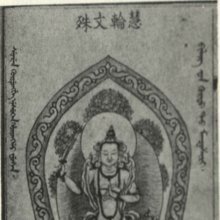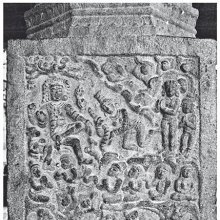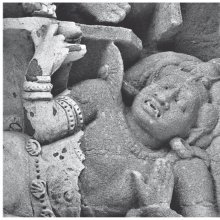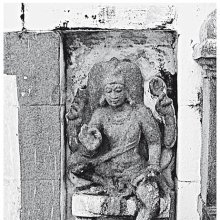Tan, Ṭan, Ṭāṅ, Taṅ, Taṇ, Taṉ, Tāṇ, Tāṉ: 17 definitions
Introduction:
Tan means something in Buddhism, Pali, Hinduism, Sanskrit, Hindi, biology, Tamil. If you want to know the exact meaning, history, etymology or English translation of this term then check out the descriptions on this page. Add your comment or reference to a book if you want to contribute to this summary article.
Images (photo gallery)
(+101 more images available)
In Hinduism
Vyakarana (Sanskrit grammar)
Source: Wikisource: A dictionary of Sanskrit grammarṬāṅ (टाङ्).—Short term for affixes beginning with टाप् (ṭāp) in P. IV. 1.4 and ending with ष्यङ् (ṣyaṅ) in P. IV. 1.78: cf. टाङिति प्रत्याहारग्रहणम् । टापः प्रभृति आ ष्यङो ङकारात् (ṭāṅiti pratyāhāragrahaṇam | ṭāpaḥ prabhṛti ā ṣyaṅo ṅakārāt) M. Bh. on I. 2.48 V. 2.
--- OR ---
1) Taṅ (तङ्).—A short term used for the nine personal endings of the Atmanepada viz. त,आताम् (ta, ātām)...महिङ् (mahiṅ) which are themselves termed Atmanepada; cf. तङानौ आत्मनेपदम् (taṅānau ātmanepadam) P. 1.4. 100
2) Taṅ.—The personal-ending त (ta) of the 2nd pers. pl. (substituted for थ (tha) by III.4 101) looked upon as तङ् (taṅ) sometimes, when it is lengthened in the Vedic Literature: cf. तङिति थादेशस्य ङित्त्वपक्षे ग्रहणम् । भरता जातवेदसम् (taṅiti thādeśasya ṅittvapakṣe grahaṇam | bharatā jātavedasam) Kas. on P. VI. 3. 133.
--- OR ---
Taṇ (तण्).—Ancient term for संज्ञा (saṃjñā) and छन्दस् (chandas) used by the Vartikakara: cf. बहुलं तणीति वक्तव्यम् । किमिदं तणीति । संज्ञाचन्दसो र्ग्रहणम् (bahulaṃ taṇīti vaktavyam | kimidaṃ taṇīti | saṃjñācandaso rgrahaṇam), M. Bh. on P. II. 4.54 Vart. 11: III. 2.8 Vart. 2; IV. 1.52. Vart. 3.

Vyakarana (व्याकरण, vyākaraṇa) refers to Sanskrit grammar and represents one of the six additional sciences (vedanga) to be studied along with the Vedas. Vyakarana concerns itself with the rules of Sanskrit grammar and linguistic analysis in order to establish the correct context of words and sentences.
In Buddhism
Theravada (major branch of Buddhism)
Source: Access to Insight: A Glossary of Pali and Buddhist TermsReverend, venerable.Theravāda is a major branch of Buddhism having the the Pali canon (tipitaka) as their canonical literature, which includes the vinaya-pitaka (monastic rules), the sutta-pitaka (Buddhist sermons) and the abhidhamma-pitaka (philosophy and psychology).
Biology (plants and animals)
Source: Wisdom Library: Local Names of Plants and DrugsTan in the Marathi language is the name of a plant identified with Chloris barbata Sw. from the Poaceae (Grass) family. For the possible medicinal usage of tan, you can check this page for potential sources and references, although be aware that any some or none of the side-effects may not be mentioned here, wether they be harmful or beneficial to health.
Source: Google Books: CRC World Dictionary (Regional names)1) Tan in India is the name of a plant defined with Cissampelos pareira in various botanical sources. This page contains potential references in Ayurveda, modern medicine, and other folk traditions or local practices It has the synonym Cocculus villosus DC. (among others).
2) Tan is also identified with Chloris barbata It has the synonym Andropogon polydactylon L. (etc.).
3) Tan is also identified with Cocculus hirsutus It has the synonym Menispermum hirsutum L. (etc.).
4) Tan in Laos is also identified with Borassus flabellifer It has the synonym Pholidocarpus tunicatus (Lour.) H. Wendl. (etc.).
Example references for further research on medicinal uses or toxicity (see latin names for full list):
· The Annals and magazine of natural history; zoology, botany, and geology (1867)
· Webbia (1914)
· Flora Brasiliensis (1878)
· Taxon (1979)
· Botanical Magazine (Tokyo) (1926)
· Systema Naturae, Editio Decima
If you are looking for specific details regarding Tan, for example pregnancy safety, diet and recipes, health benefits, side effects, extract dosage, chemical composition, have a look at these references.

This sections includes definitions from the five kingdoms of living things: Animals, Plants, Fungi, Protists and Monera. It will include both the official binomial nomenclature (scientific names usually in Latin) as well as regional spellings and variants.
Languages of India and abroad
Pali-English dictionary
Source: Sutta: The Pali Text Society's Pali-English DictionaryṬan, (?) (adv.) part of sound J. I, 287 (ṭan ti saddo). (Page 288)

Pali is the language of the Tipiṭaka, which is the sacred canon of Theravāda Buddhism and contains much of the Buddha’s speech. Closeley related to Sanskrit, both languages are used interchangeably between religions.
Sanskrit dictionary
Source: DDSA: The practical Sanskrit-English dictionaryTan (तन्).—I. 8 U. (tanoti, tanute, tatāna, tene, ata-tā-nīt, tanitum, tataḥ pass. tanyate or tāyate; desid. titaṃsati, titāṃsati titaniṣati)
1) To stretch, extend, lengthen, lengthen out; बाह्वोः सकरयोस्त- तयोः (bāhvoḥ sakarayosta- tayoḥ) Ak.
2) To spread, shed, diffuse; कूलानि साऽऽमर्षतयेव तेनुः सरोजलक्ष्मीं स्थलपद्महासैः (kūlāni sā''marṣatayeva tenuḥ sarojalakṣmīṃ sthalapadmahāsaiḥ) Bhaṭṭikāvya 2.3;1.32;15.91; Ku. 2.33.
3) To cover, fill; स तमीं तमोभिरभिगम्य तताम् (sa tamīṃ tamobhirabhigamya tatām) Śiśupālavadha 9. 23; Kirātārjunīya 5.11.
4) To cause, produce, form, give, grant, bestow; त्वयि विमुखे मयि सपदि सुधानिधिरपि तनुते तनुदाहम् (tvayi vimukhe mayi sapadi sudhānidhirapi tanute tanudāham) Gītagovinda 4; पितुर्मुदं तेन ततान सोऽर्भकः (piturmudaṃ tena tatāna so'rbhakaḥ) R.3.25;7.7; Uttararāmacarita 3. 39; Mālatīmādhava (Bombay) 9.43; यो दुर्जनं वशयितुं तनुते मनीषाम् (yo durjanaṃ vaśayituṃ tanute manīṣām) Bv.1.95, 1.
5) To perform, do, accomplish (as a sacrifice); इति क्षितीशो नवतिं नवाधिकां महाक्रतूनां महनीयशासनः । समारुरुक्षुर्दिव- मायुषः क्षये ततान सोपानपरंपरामिव (iti kṣitīśo navatiṃ navādhikāṃ mahākratūnāṃ mahanīyaśāsanaḥ | samārurukṣurdiva- māyuṣaḥ kṣaye tatāna sopānaparaṃparāmiva) || R.3.69; Manusmṛti 4.25.
6) To compose, write (as a work &c.); as in नाम्नां मालां तनोम्यहम् (nāmnāṃ mālāṃ tanomyaham) or तनुते टीकाम् (tanute ṭīkām).
7) To stretch or bend (as a bow).
8) To spin out, weave.
9) To propagate, or be propagated; धमार्थ उत्तमश्लोकं तन्तुं तन्वन्पितॄन्यजेत् (dhamārtha uttamaślokaṃ tantuṃ tanvanpitṝnyajet) Bhāgavata 2. 3.8.
1) To continue, last.
11) To protract, prolong, augment; मुदितस्तं चिरमुत्सवं ततान (muditastaṃ ciramutsavaṃ tatāna) Kathāsaritsāgara 51.226; पितुर्मुदं तेन ततान सोऽर्भकः (piturmudaṃ tena tatāna so'rbhakaḥ) R.3.25.
12) To emboss.
13) To prepare (a way for); यज्ञैरथर्वा प्रथमः पथस्तते (yajñairatharvā prathamaḥ pathastate) Ṛgveda 1.83.5.
14) To direct one's way towards.
15) To compose (a literary work). [cf. L. tendo]. -II. 1 P., 1 U. (tanati, tānayati- te)
1) To confide, trust, place confidence in.
2) To help, assist, aid.
3) To pain or afflict with disease.
4) To be harmless.
5) To sound.
--- OR ---
Tan (तन्).—f. Ved.
1) Continuation, diffusion.
2) Offspring, posterity.
Source: Cologne Digital Sanskrit Dictionaries: Shabda-Sagara Sanskrit-English DictionaryTan (तन्).—[(u) tanu] r. 8th cl. (tanoti-tanute) To expand, to spread, to extend, to diffuse, to dilate, &c. physically or morally. r. 1st and 10th cls. (tanati tānayatite) 1. To confide, to believe or have faith in. 2. To aid, to assist. 3. To be harmless. 4. To sound. 5. To pain or afflict with disease. 6. (With a preposition,) To lengthen, to stretch, to expand, &c. as in the 8th cl.
Source: Cologne Digital Sanskrit Dictionaries: Benfey Sanskrit-English DictionaryTan (तन्).—ii. 8, tanu, [Parasmaipada.], [Ātmanepada.] 1. To draw (a bow), Mahābhārata 4, 141. 2. To spread, [Bhagavadgītā, (ed. Schlegel.)] 2, 17. 3. To cover, [Śiśupālavadha] 9, 23. 4. To propagate, [Harivaṃśa, (ed. Calc.)] 2386. 5. To augment, [Śākuntala, (ed. Böhtlingk.)] [distich] 19. 6. To direct, [Nalodya, (ed. Benary.)] 1, 20. 7. To arrange, [Mānavadharmaśāstra] 4, 205. 8. To cause (pleasure or pain), [Raghuvaṃśa, (ed. Stenzler.)] 3, 25; [Bhāgavata-Purāṇa, (ed. Burnouf.)] 1, 18, 37. 9. To speak, [Daśakumāracarita] 7 ult. Pass. tanya, and tāya; ptcple. tata.
— With the prep. ati ati, atitata, Very haughty, [Śiśupālavadha] 19, 3.
— With adhi adhi, To cover, [Rāmāyaṇa] 5, 12, 33.
— With anu anu, 1. To augment, Mahābhārata 12, 4816. 2. To maintain, Mahābhārata 3, 12681.
— With ava ava, 1. To descend, avatata, Descending, [Harivaṃśa, (ed. Calc.)] 3621. 2. To cover, Mahābhārata 6, 2666.
—
— With ā ā, 1. with padam, To get a footing, [Bhartṛhari, (ed. Bohlen.)] 1, 32. 2. To stretch, Mahābhārata 5, 4164; to draw, [Raghuvaṃśa, (ed. Stenzler.)] 1, 19. 3. To effuse, [Śākuntala, (ed. Böhtlingk.)] [distich] 193. 4. To grant, [Bhāgavata-Purāṇa, (ed. Burnouf.)] 5, 24, 22. 5. To cause, [Bhartṛhari, (ed. Bohlen.)] 1, 50. 6. To arrange, [Bhartṛhari, (ed. Bohlen.)] 1, 36.
— With samā sam-ā, To procure, [Rājataraṅgiṇī] 4, 247. samātata, Violent, Mahābhārata 8, 4205.
— With pra pra, 1. To spread, [Suśruta] 1, 354, 5. 2. To show, [Śiśupālavadha] 2, 30. 3. To cover, [Rāmāyaṇa] 3, 76, 25. 4. To begin (a sacrifice), Mahābhārata 12, 9613. 5. To cause, [Rājataraṅgiṇī] 2, 78.
— With vi vi, 1. To spread out, Mahābhārata 1, 1335. 2. To stretch out, [Mṛcchakaṭikā, (ed. Stenzler.)] 143, 21. 3. To draw, Mahābhārata 1, 5290. 4. To cover, [Rāmāyaṇa] 3, 63, 13. 5. To arrange (a sacrifice), [Mānavadharmaśāstra] 3, 28. 6. To show, [Rāmāyaṇa] 4, 9, 89. vitata, 1. Large, [Bhāgavata-Purāṇa, (ed. Burnouf.)] 5, 16, 7. 2. Powerful, [Rājataraṅgiṇī] 5, 22.
— With āvi ā-vi, To illuminate, [Bhāgavata-Purāṇa, (ed. Burnouf.)] 5, 20, 37.
— With pravi pra-vi, pravitata, 1. Large, [Meghadūta, (ed. Gildemeister.)] 104. 2. Begun, Mahābhārata 5, 5317.
— With sam sam, 1. To cover, [Rāmāyaṇa] 6, 21, 1. 2. To fill up, [Bhāgavata-Purāṇa, (ed. Burnouf.)] 8, 23, 14. 3. To expand, [Bhāgavata-Purāṇa, (ed. Burnouf.)] 1, 3, 37. saṃtata, 1. Uninterrupted, [Lassen, Anthologia Sanskritica.] 96, 9. 2. Eternal. 3. Extended. 4. Much. ºtam, adv. Eternally. [Causal.] tānaya, To cause to be performed, [Bhāgavata-Purāṇa, (ed. Burnouf.)] 4, 7, 16.
— With anusam anu -sam, 1. To spread, [Bhagavadgītā, (ed. Schlegel.)] 15, 2. 2. To cover, [Rāmāyaṇa] 5, 16, 8.
— With abhi- sam abhi-sam, To cover, [Harivaṃśa, (ed. Calc.)] 4986.
— Cf. (= tata), (for ), (for ), (for + tvas); [Latin] tenere, tendere, ostendere (for obs-). tenus, etc.; [Old High German.] danjan; [Anglo-Saxon.] thenian; see also tanu.
--- OR ---
Tan (तन्).— (akin to stan), i. 4, [Parasmaipada.] To sound (ved.).
— Cf. [Latin] tonare; [Old High German.] donar; [Anglo-Saxon.] thunor.
--- OR ---
Tan (तन्).— (or van Van), i. 1 and 10, tānaya, [Parasmaipada.] 1. To believe. 2. To assist (or to afflict, or to be afflicted). 3. To sound (cf. 2. tan). 4. With prepositions, To stretch (cf. 1. tan).
Source: Cologne Digital Sanskrit Dictionaries: Cappeller Sanskrit-English DictionaryTan (तन्).—1. tanoti tanute [participle] tata (q.v.) extend, stretch, spread ([intransitive] & tr.); last, continue; protract, prolong, lengthen; spin out, weave (l.&[feminine]); prepare, arrange, direct, accomplish, perform, compose, make. [Passive] tāyate be extended, increase, grow.
--- OR ---
Tan (तन्).—2. (only [dative] & [instrumental]) spreading, continuation, propagation, offspring; [instrumental] tanā (tanā) [adverb] uninterruptedly, continually.
--- OR ---
Tan (तन्).—3. tanyati roar.
Source: Cologne Digital Sanskrit Dictionaries: Monier-Williams Sanskrit-English Dictionary1) Tan (तन्):—[from tat] a in [compound] for tad.
2) 1. tan [class] 1. 10. nati, tānayati, to believe in [Dhātupāṭha];—‘to assist’ or ‘to afflict with pain’ [ib.]
3) 2. tan (= √stan) [class] 4. nyati ([Aorist] 2. sg. tatanas) to resound, roar, [Ṛg-veda i, 38, 14; vi, 38, 2];—(cf. τόνος etc.)
4) 3. tan [class] 8. [Ātmanepada] [Parasmaipada] noti, nute (3. [plural] nvate [āand vi-tanvate, [Ṛg-veda]] [Atharva-veda xii, 1, 13]; [imperative] nu [ava and vi-tanuhi, [Ṛg-veda]; cf. [Pāṇini 6-4, 106], [vArttika] 1, [Patañjali]] [Ṛg-veda i, 120, 11]; nuṣva, [Ṛg-veda]; [subjunctive] 2. sg. nuthās, [v, 79, 9]; 1. [dual number] navāvahai, [i, 170, 4]; [imperfect tense] 3. [plural] atanvata, [x, 90, 6; Atharva-veda vii, 5, 4]; [perfect tense] [Parasmaipada] tatāna, once tāt, [Ṛg-veda i, 105, 12]; 2. sg. tatantha [Ṛg-veda], class. tenitha [Pāṇini 7-2, 64; Kāśikā-vṛtti]; [Ātmanepada] 1. 2. 3. sg. [ā-] tatane, [abhi-] tatniṣe, [vi-] tatne, [Ṛg-veda]; 3. sg. [irregular] tate, [i, 83, 5]; 3. [plural] tatnire [164, 5] vi-, [Atharva-veda xiv, 1, 45] or ten [iv, 14, 4] (vi-) etc.; cf. [Pāṇini 6-4, 99]; [Aorist] [Parasmaipada] atan, [Ṛg-veda vi, 61, 9]; [ā-] atān, [67, 6; Atharva-veda ix, 4, 1; pari-,vi-] atanat, [Ṛg-veda]; [anv-ā] atāṃsīt, [Vājasaneyi-saṃhitā xv, 53]; atānīt, [Maitrāyaṇī-saṃhitā]; tatanat, [abhi-] tanāma, tanan, [Ṛg-veda]; 2. [plural] ataniṣṭa, [Pāṇini 2-4, 79; Kāśikā-vṛtti]; 3. [dual number] atāniṣṭām, [Bhaṭṭi-kāvya xv, 91]; [Ātmanepada] atata or ataniṣṭa, atathās or ataniṣṭhās, [Pāṇini 2-4, 79]; 3. [plural] atnata, [Ṛg-veda]; tatananta, [i, 52, 11]; 1. sg. atasi [plural] ataṃsmahi, [Brāhmaṇa]; [future] 2nd taṃsyate, [Śatapatha-brāhmaṇa]; [future] 1st [vi-] tāyitā, [Bhāgavata-purāṇa viii, 13, 36] ; p. pr. tanvat, vāna; [perfect tense] tatanvas; [indeclinable participle] tatvā, tvāya, -tatya, [Brāhmaṇa; vi-] tāya, [Bhāgavata-purāṇa vii, 10, 2]; [infinitive mood] tantum, [Brāhmaṇa]; [Passive voice] tāyate, [Ṛg-veda i, 110, 1 &]p. yamāna [x, 17, 7; Atharva-veda] etc.; tanyate, [Pāṇini 6-4, 44]; [Aorist] atāyi, [Brāhmaṇa])
—to extend, spread, be diffused (as light) over, shine, extend towards, reach to, [Ṛg-veda] etc.;
—to be protracted, continue, endure, [Ṛg-veda];
—to stretch (a cord), extend or bend (a bow), spread, spin out, weave, [Ṛg-veda] etc.;
—to emboss, [Śatapatha-brāhmaṇa xiv, 7, 2, 5];
—to prepare (a way for), [Ṛg-veda i, 83, 5];
—to direct (one’s way, gatim) towards, [Nalôd. i, 20];
—to propagate (one’s self or one’s family, tanūs, tantum), [Harivaṃśa 2386; Bhāgavata-purāṇa ii, 3, 8];
—to (spread id est. to) speak (words), [Daśakumāra-carita i, 87];
—to protract, [Ṛg-veda v, 79, 9; Kathāsaritsāgara li, 226];
—to put forth, show, manifest, display, augment, [Raghuvaṃśa iii, 25; Śakuntalā; Bhartṛhari] etc. ([Passive voice] to be put forth or extended, increase, [Bhaṭṭi-kāvya]);
—to accomplish, perform (a ceremony), [Ṛg-veda; Vājasaneyi-saṃhitā ii, 13; Atharva-veda iv, 15, 16; Śatapatha-brāhmaṇa] etc.;
—to sacrifice, [xiii, 2, 5, 2; Kauśika-sūtra 127];
—to compose (a literary work), [Hemacandra; Caurapañcāśikā [Scholiast or Commentator]];
—to render (any one thirsty, double [accusative]), [Kuvalayānanda 455] :—[Desiderative] titaniṣati, taṃsati, tāṃs, [Pāṇini 6-4, 17; vii, 2, 49; Kāśikā-vṛtti]:—[Intensive] tantanyate, tantanīti, [vi, 4, 44 & vii, 4, 85; Kāśikā-vṛtti];—(cf. τάνομαι, τείνω etc.)
5) 4. tan m. (only [dative case], tane and [instrumental case] tanā) continuation, uninterrupted succession, [Ṛg-veda]
6) propagation, offspring, posterity, [Ṛg-veda] ([tanvā tanā ca or tmanā tānā or tanve tane (ca), ‘for one’s own person and one’s children’])
Source: Cologne Digital Sanskrit Dictionaries: Yates Sanskrit-English DictionaryTan (तन्):—(da, u) tanoti, tanute 8. c. To expand, to extend. (ki) nanati tanayati 1. 10. a. To confide; to aid; to be harmless; to sound; be in pain. With prep. to extend.
Source: DDSA: Paia-sadda-mahannavo; a comprehensive Prakrit Hindi dictionary (S)Tan (तन्) in the Sanskrit language is related to the Prakrit words: Taḍa, Taḍḍa, Taḍḍava, Taṇa, Viralla.
[Sanskrit to German]
Sanskrit, also spelled संस्कृतम् (saṃskṛtam), is an ancient language of India commonly seen as the grandmother of the Indo-European language family (even English!). Closely allied with Prakrit and Pali, Sanskrit is more exhaustive in both grammar and terms and has the most extensive collection of literature in the world, greatly surpassing its sister-languages Greek and Latin.
Hindi dictionary
Source: DDSA: A practical Hindi-English dictionary1) Tan in Hindi refers in English to:—(nm) (a measure of weight) ton; (nf) a tinkling/twanging sound; ~[tana] ding-dong; ting, peal..—tan (टन) is alternatively transliterated as Ṭana.
2) Tan in Hindi refers in English to:—(nm) body; —[ki -tapana bujhana] to quench the thirst of one’s physical needs, to attain physical gratification; —[badana ki sudha na rahana] to transcend one’s physical being, to be beyond oneself; -[badana mem aga lagana] to get one’s goat; -[mana se] wholeheartedly, with all physical and mental resources; -[mana-dhana se] with all physical, mental and material resources; -[mana se seva karana] to serve somebody hand and foot..—tan (तन) is alternatively transliterated as Tana.
...
Kannada-English dictionary
Source: Alar: Kannada-English corpusṬan (ಟನ್):—[noun] = ಟನ್ನು [tannu].
--- OR ---
Taṇ (ತಣ್):—[verb] to become cool or colder; to lose temperature.
--- OR ---
Taṇ (ತಣ್):—[adjective] that is cool or cold.
--- OR ---
Taṇ (ತಣ್):—[noun] the condition of having temperature below normal; coldness; chilliness.
--- OR ---
Tān (ತಾನ್):—
1) [pronoun] base form of the pronoun (corresponding to he, she, it in English) used in reflexive or reciprocal sense2) [pronoun] ತಾನು ಮಾಡುವುದು ಉತ್ತಮ, ಮಗ ಮಾಡುವುದು ಮಧ್ಯಮ, ಆಳುಮಾಡುವುದು ಹಾಳು [tanu maduvudu uttama, maga maduvudu madhyama, alumaduvudu halu] tānu māḍuvudu uttama, maga māḍuvudu madhyama,āḷu māḍuvudu hāḷu (prov.) self-done is well done; ತಾನು ಹಿಡಿದ ಮೊಲಕ್ಕೆ ಮೂರು ಕೊಂಬು [tanu hidida molakke muru kombu] tānu hiḍida molakke mūru kombu (prov.) all that one does must be right; all that he says is law; ತಾನೂ ತಿನ್ನ, ಬೇರೆಯವರಿಗೂ ಕೊಡ [tanu tinna, bereyavarigu koda] tānū tinna, bēreyavarigū koḍa (prov.) he neither enjoys, nor does he allow others enjoy.
Kannada is a Dravidian language (as opposed to the Indo-European language family) mainly spoken in the southwestern region of India.
Tamil dictionary
Source: DDSA: University of Madras: Tamil LexiconTaṇ (தண்) noun
1. [Kanarese, Malayalam: taṇ.] Coolness, coldness; குளிர்ச்சி. (பிங்கலகண்டு) [kulirchi. (pingalagandu)]
2. Water; நீர். [nir.] Brāh.
3. Grace; love; அருள். தண்கலந்த சிந்தையோடு [arul. thankalantha sinthaiyodu] (சேதுபுராணம் சீதைகுண்ட. [sethupuranam sithaigunda.] 5).
--- OR ---
Taṉ (தன்) pronominal < தான். [than.] Oblique case-form of the pronoun tāṉ; தான் என்ற சொல் வேற்றுமை யுருபை ஏற்குமிடத்துப் பெறுந் திரிபு. [than enra sol verrumai yurupai erkumidathup perun thiripu.]
--- OR ---
Tāṇ (தாண்) noun Vegetable piece in curry. See தான்². [than².] Local usage
--- OR ---
Tāṉ (தான்) [K. tān.] pronominal
1. He, she or it; படர்க்கை யொருமைப்பெயர். தன்னைத் தலையாகச் செய்வானுந் தான் [padarkkai yorumaippeyar. thannaith thalaiyagas seyvanun than] (நாலடியார் [naladiyar], 248).
2. Oneself; சுயம். தானாகப் படித்தவன். [suyam. thanagap padithavan.] — particle
1. A word used as intensive; தேற்றச்சொல். உனைத் தான் நோக்கி நிற்கும் [therrachol. unaith than nokki nirkum] (வெங்கைக்கோ. [vengaikko.] 41).
2. Expletive affixed to any noun or pronoun and declined instead of it; அசைச்சொல். தாந்தான் கின்று நின்றசைமொழி [asaichol. thanthan kinru ninrasaimozhi] (நன். [nan.] 441). — conj. Besides; அதுவன்றி இஃது ஒன்று என்று பொருள்படுவதோர் இடைச்சொல். [athuvanri iqthu onru enru porulpaduvathor idaichol.] (திருக்கோவையார் [thirukkovaiyar] 382, உரை. [urai.])
--- OR ---
Tāṉ (தான்) noun < Urdu thān.
1. Piecegoods; முழுத்துணிக்கச்சை. [muzhuthunikkachai.] Colloq.
2. cf. தாண். [than.] Pieces of vegetables in curry broth; குழம்பில் போடப்படும் துண்டம். [kuzhambil podappadum thundam.]
Tamil is an ancient language of India from the Dravidian family spoken by roughly 250 million people mainly in southern India and Sri Lanka.
See also (Relevant definitions)
Starts with (+2008): Taanchaa, Taando, Taanginu, Tadi, Tamadhya, Tamadhyat, Tamanin, Tamatraka, Tamaya, Tamcavamca, Tamdal, Tamdalalika, Tamdamberu, Tamdamgol, Tamdamumda, Tamdaname, Tamdanatana, Tamdanatanana, Tamdannata, Tamdanotanani.
Ends with (+1381): Abhinihstan, Abhipratan, Abhisamtan, Abhistan, Abhitan, Abhivitan, Abhyatan, Abhyavatan, Acalakattan, Acamarttan, Acantan, Accutan, Acikarttan, Acintitan, Adhitan, Adhunatan, Adytan, Afghanistan, Aflamantan, Aflatan.
Full-text (+7178): Dhan, Tana, Dan, Tanus, Pratati, Tada, Tan-kulamvetti, Shuddhadat, Dvidat, Atinittan, Caturdat, Patat, Tanas, Civapatam, Tanpatu, Parahsahasra, Tankatir, Parisamtana, Adhika, Tanmalaikkaraci.
Relevant text
Search found 536 books and stories containing Tan, Ṭan, Ṭāṅ, Taṅ, Taṇ, Taṉ, Tāṇ, Tāṉ, Tān, Than, Dan, Dhan, Thaan; (plurals include: Tans, Ṭans, Ṭāṅs, Taṅs, Taṇs, Taṉs, Tāṇs, Tāṉs, Tāns, Thans, Dans, Dhans, Thaans). You can also click to the full overview containing English textual excerpts. Below are direct links for the most relevant articles:
Tiruvaymoli (Thiruvaimozhi): English translation (by S. Satyamurthi Ayyangar)
Pasuram 5.4.8 < [Section 4 - Fourth Tiruvaymoli (Ur ellam tunci)]
Pasuram 5.2.2 < [Section 2 - Second Tiruvaymoli (Polika Polika)]
Pasuram 2.5.8 < [Section 5 - Fifth Tiruvaymoli (Am Tamattu Anpu)]
Hari-bhakti-kalpa-latikā (by Sarasvati Thkura)
Chaitanya Bhagavata (by Bhumipati Dāsa)
Verse 3.1.35 < [Chapter 1 - Meeting Again at the House of Śrī Advaita Ācārya]
Verse 3.9.136 < [Chapter 9 - The Glories of Advaita]
Verse 2.17.19 < [Chapter 17 - The Lord’s Wandering Throughout Navadvīpa and Descriptions of the Devotees’ Glories]
Diamond Jubilee Number < [October – December, 1988]
Vaishnava Janato < [October – December, 1997]
Salutation to Ramakotiswara Rau < [October – December, 1988]
Manusmriti with the Commentary of Medhatithi (by Ganganatha Jha)
Verse 10.20 < [Section II - Mixed Castes]
Verse 2.151 < [Section XXV - Meaning of the Title ‘Ācārya’]
Verse 11.210 < [Section XXIX - Description of the Expiatory Penances]
Parables of Rama (by Swami Rama Tirtha)
Story 233 - Cure of Ignorance < [Chapter XLIV - Knowledge]
Story 60 - Why things are dear < [Chapter IX - Love]
Story 195 - Lord Indra & his piggish thoughts < [Chapter XXXIV - Thought Power]
Related products
(+85 more products available)











